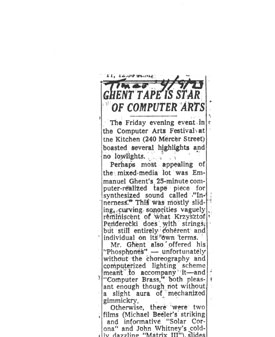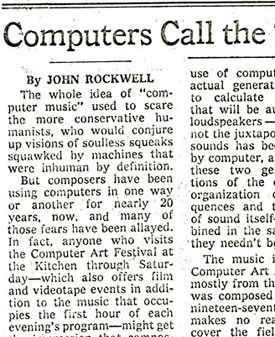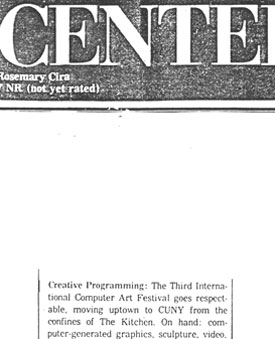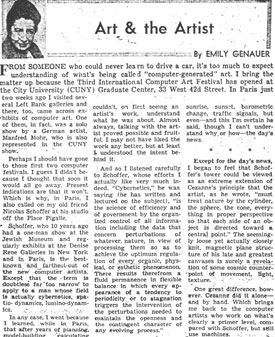A Kinetic History: The EAI Archives Online
A Kinetic History: The EAI Archives Online
Articles & Reviews
This page includes selected articles, reviews and announcements of the three International Computer Art Festivals, which were held at the Kitchen in from 1973 and 1974, and at the City University of New York in 1975. Four of the articles were written by John Rockwell, music critic and later the music editor (currently dance editor) for The New York Times. Please click on the links below to read the texts.
John Rockwell, "Computer Borrows Masters' Frailties In Music Festival."
New York Times (April 4, 1973)
In this article John Rockwell reports from one of the initial days of the first International Computer Art Festival. The event seems to suffer from technical difficulties, but Rockwell is still taken by the performances and states that computer arts is a field of limitless promise. The most intriguing event of the evening was by Bill Etra and Steven Rutt, who presented their new video synthesizer, which, according to Rockwell, could do wondrous things to an image. Rockwell praises two pieces of computer music by Joseph Olive as the most successful presentations of the night. The works were realized at Bell Laboratories, where Olive later became director of language modeling.
John Rockwell, "Ghent Tape is Star of Computer Arts."
New York Times (April 9, 1973)
This short article contains John Rockwell's enthusiastic evaluation of the Friday events at the first International Computer Art Festival. According to Rockwell the most appealing work was Innerness (1970), a 25-minute tape with synthesized sound, made at Bell Laboratories by Emmanuel Ghent. He also mentions works by Michael Beeler, John Whitney, Lou Katz, and Walter Wright.
John Rockwell, "A Diverse Program of Computer Arts."
New York Times (April 11, 1973)
John Rockwell reports from the second Monday's events of the first International Computer Art Festival, describing the evening as something of a media blitz. Computers can be used artistically in almost as many ways as people can think to make art, and Monday's offerings showed an impressive diversity. Rockwell discusses the presentations and hails Charles Dodge's Speech Songs (1972) as the most unusual of them all and strikingly expressive. Works by Dimitri Devyatkin, Gary Nelson, Lillian Schwartz, Ed Emshwiller, and Alison Knowles are also discussed.
John Rockwell, "Computers Call the Tune at the Kitchen."
New York Times (June 11, 1974)
In this extensive article, John Rockwell discusses computer music as a genre, and the computer as a tool, stating that a computer never creates music, but only performs tasks given to it by a human programmer. After a general discussion, Rockwell reviews the second International Computer Art Festival and finds the material on display somewhat unadventurous. He urges artists creating music with computers to avoid seeking to replicate live instrumental sounds, but to dig deeper into the potential of their tool, the computer. He suggests that the more active a role the computer takes in the creative process, the better the result. The article discusses works by Frank Brickle, John Melby, Randall, Emmanuel Ghent, and Charles Dodge.
Alexandra Anderson (ed). "Creative Programming."
Voice Centerfold (June 12-18, 1975)
This short announcement notes that the Third International Computer Art Festival has gone respectable by moving uptown from The Kitchen to the City University of New York, and mentions the workshops and seminars. It concludes, It's the future! Take a chance.
Emily Genauer, "Art & the Artist."
New York Post (June 21, 1975): 34.
This full-page article was published in relation to the third International Computer Art Festival. The author, Emily Genauer, mainly discusses the work of Nicolas Schoffer, a pioneer of cybernetic art. Genauer describes her struggle to find links between art history and the new trends in art and technology. Her conclusion is that artists have always used tools for making work and that the computer is a tool just like any other. She suggests that it ultimately relies on the artist's vision and how skillfully it is transformed into an object, whether the pencil in his hand or the panel of a monster machine.





